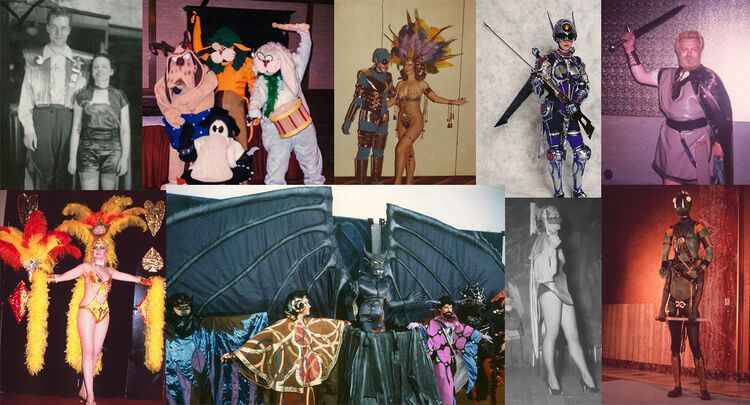Convention Costuming History
Wearing costumes has been a part of science fiction conventions from the very beginning, starting with the first Worldcon in 1939, when Forrest J Ackerman and Myrtle Douglas wore their iconic costumes. The first costume contest occurred the following year, in an informal manner, resembling a party. Worldcon was put on hold from 1942-1945. In 1946, Worldcon resumed, and the popularity of the costume contests grew with more participants showcasing a range of costumes from simple masks to elaborate designs.
During the 1950s to early 1960s, costume balls were commonly held to entertain the attendees during judging, often featuring live bands. Over time, the balls transitioned to putting people on raised platform stages, allowing the audience to better view the costumes. This led to masquerades, which include many theatrical elements like lights and music and special effects. Over the years, participants began to take their creations more seriously, gaining reputations for memorable costumes that convention attendees eagerly anticipated.
Each contestant had their own reasons and motivations for costuming, but they all sought to entertain and express their creativity in a way that fellow science fiction and fantasy fans could relate to. Over the years, the subject trends in costumes have evolved, reflecting popular culture, technological advancements, and societal changes. From classic science fiction and fantasy characters to modern superheroes and intricate original designs, the variety and complexity of costumes have grown tremendously.
For decades, convention costuming was seen as a niche and somewhat "weird" hobby, but with the rise of the cosplay phenomenon, it has gone mainstream. The number of people participating in costuming has exploded, reflecting a broader cultural acceptance and enthusiasm for this form of self-expression. The evolution of these contests into masquerades, along with the impact of societal issues like cultural appropriation and significant events such as the Pandemic, has shaped the hobby. The history of convention costuming also includes trends in costume creation, technological advancements, and profiles of notable artists and their work. This history has been researched and written using various fan publications, magazines, masquerade videos, photographs, and other sources. It is not a complete history and will be updated as new information is discovered.
The History of Convention Costuming is organized into a year-by-year chronology, highlighting what was worn, who wore it, the winners, and any significant innovations or changes, etc. Additional sections will cover individual costumers, technological innovations, new materials, and other topics deserving their own articles, providing a comprehensive view of the rich history and ongoing developments in the world of convention costuming.
===========================================================================================[edit]
Year By Year
Convention Costuming History: 1939 - How It Started
===========================================================================================[edit]
Sidebars
Convention Costuming History: The Futuristicostumes
Convention Costuming History: Two Futuristicostume-Related Mysteries
Watch for more articles in the future!
